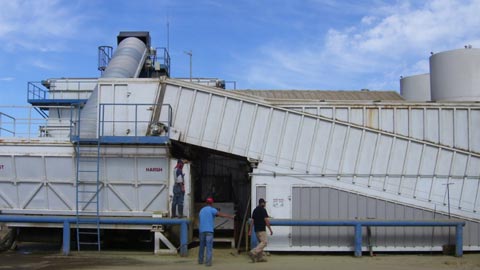Synchronous technology enables development of breakthrough machine
Synchronous technology enables development of breakthrough machine

Case Study
Agricultural machinery manufacturer reduces design time from three weeks to three days with help of Solid Edge
Harsh International
Synchronous technology enables Harsh International to develop breakthrough machine
Providing new solutions
A small manufacturing company on Colorado’s rural central plain embraces innovation, adopting new technology and inventing new agricultural machinery along the way. Harsh International (Harsh) may be small by American corporate standards, but it designs and builds massive machines for the rapidly changing feedlot and dairy business.
Faced with stiff global competition to innovate and design better products, Harsh implemented Solid Edge® software from product lifecycle management (PLM) specialist Siemens Digital Industries Software as its computer-aided design (CAD) software.
Harsh adapts with innovation
Harsh routinely adopts and succeeds with new technologies. The company was started in the late 1940s, applying new underwater welding techniques learned by its founder, Bud Harsh, during World War II. Harsh applied the welding techniques he learned as he saved the lives of American sailors trapped in sinking war ships in the Pacific Ocean.
As the post-war economy and population grew, so did farms all over the world, including in Harsh’s rural Colorado. Demand for new, innovative agricultural machinery grew with the times, and Harsh invented and became the world’s largest supplier of truck hoists, a staple in agricultural applications.
In the past several decades, smaller family-owned farms diminished as large corporate operations became the norm. So did the size of the tools and the need for large, customized cattle feeders, mixers and spreaders. This required the state-of-the-art 3D engineering software, robotics, computer numerical control (CNC) machining centers, lasers and water jets. As a result, automation, production and profits jumped.
Market demands better designs
New demands from customers and the dealers who sell Harsh equipment require innovative technologies. “Small feedlots are being purchased by the bigger companies,” says Kenny McDaniel, engineering consultant at Harsh. Equipment requirements are getting bigger, requiring Harsh to adapt designs.
“Everything is modeled in 3D CAD using synchronous technology within Solid Edge,” says McDaniel. “This allows us to quickly change designs as customers demand. We get both 2D and 3D data from vendors and customers that we need to adapt. Synchronous technology allows us to quickly change that to meet the design requirements for our customers.”
According to McDaniel, Harsh’s ability to quickly change its designs differentiates it from the competition.
“They’re taking their existing design and, if it fits into what the customer needs, that’s fine,” says McDaniel. “But if it’s anything outside of that, they’re not going to be able to do it, whereas we can use the synchronous technology in Solid Edge.”
Harsh maintains a lot of old 2D AutoCAD® software data as well as 3D data created in history-based 3D modeling. The company can leverage that work by bringing it into the synchronous technology environment and quickly manipulating it. McDaniel said that without synchronous technology, those projects would have to be re-designed from scratch.
In addition, McDaniel documented a couple of other projects in which synchronous technology provided major time savings.
”We received a custom design order that would take two or three weeks in the old history-based modeling process,” says McDaniel. “But with the synchronous technology of Solid Edge, we did it in three days. Another, much larger, project involving a 100-ton spreader that would have taken us 12 to 18 months using history-based 3D CAD, took us just six months with synchronous technology.
“Solid Edge with synchronous technology is changing our engineering, it’s changing our company and it’s changing our industry.”
